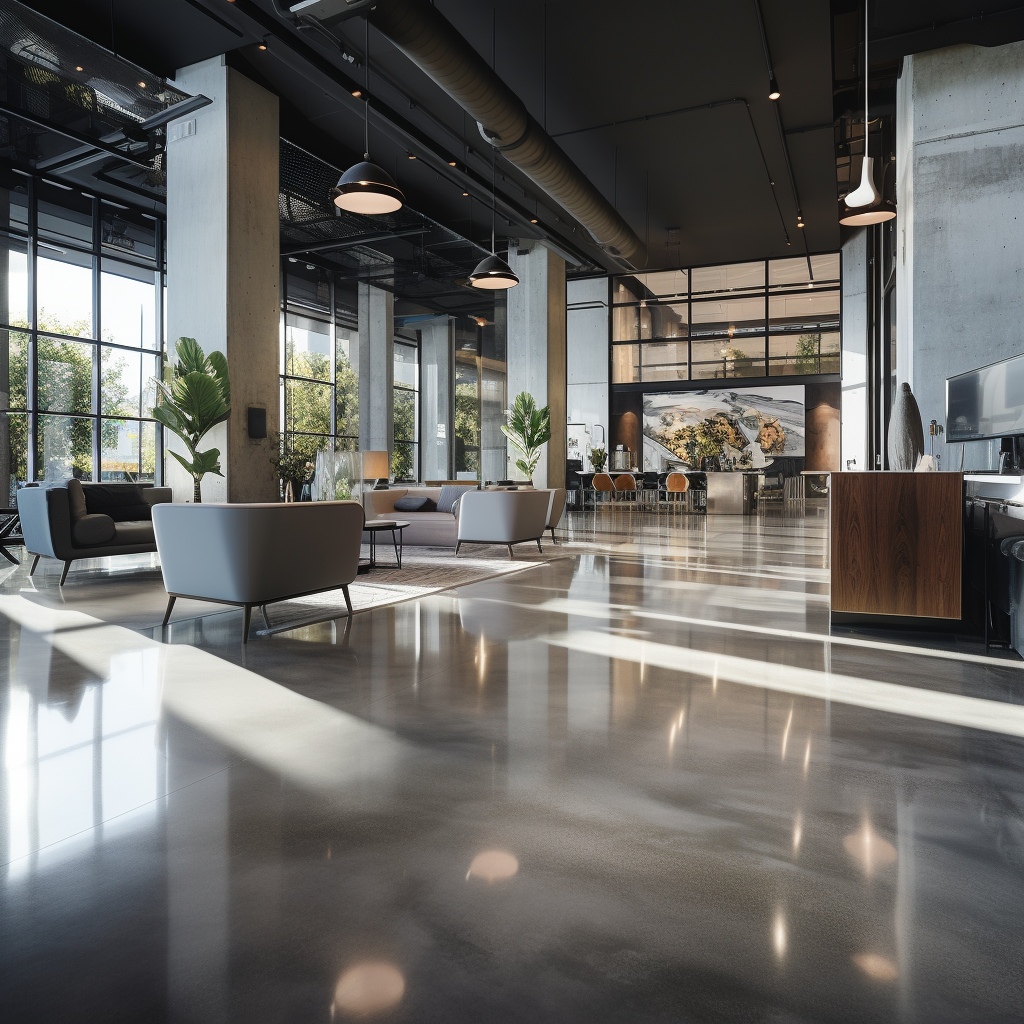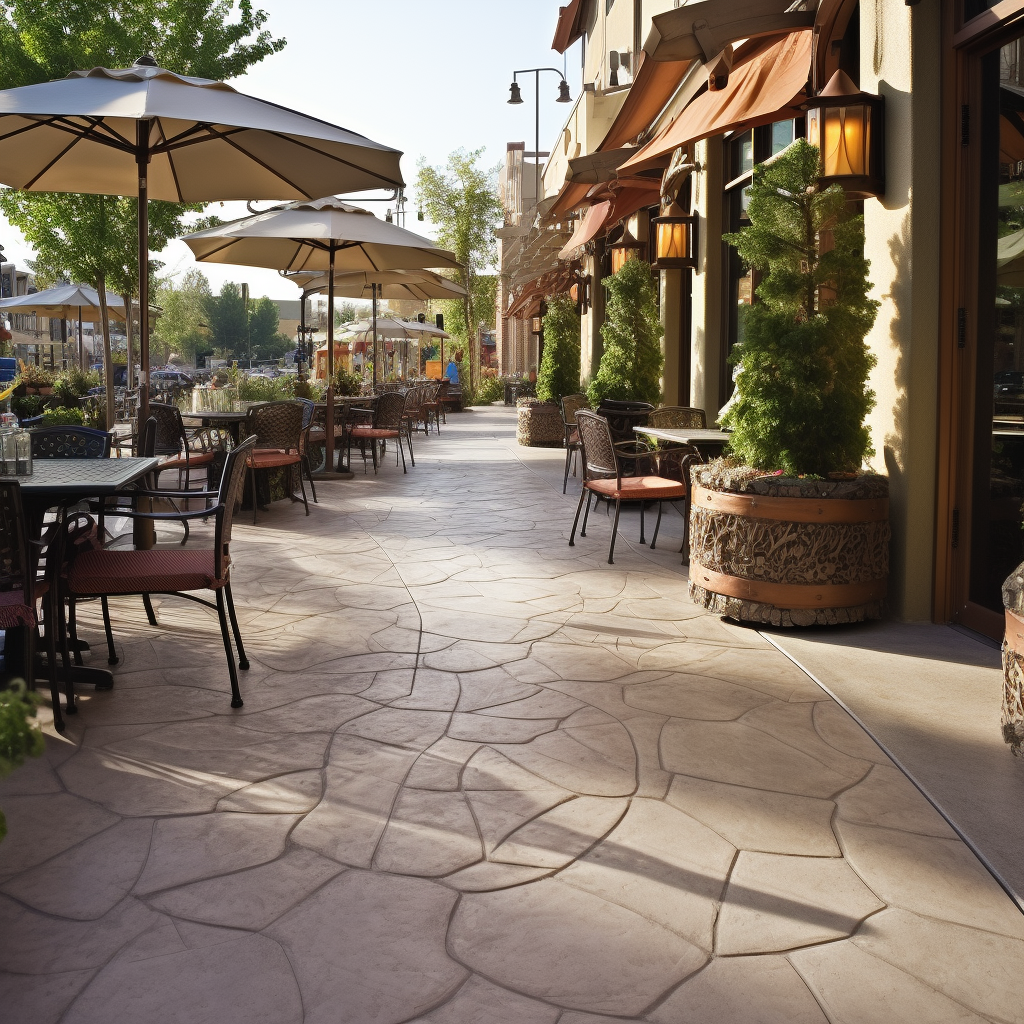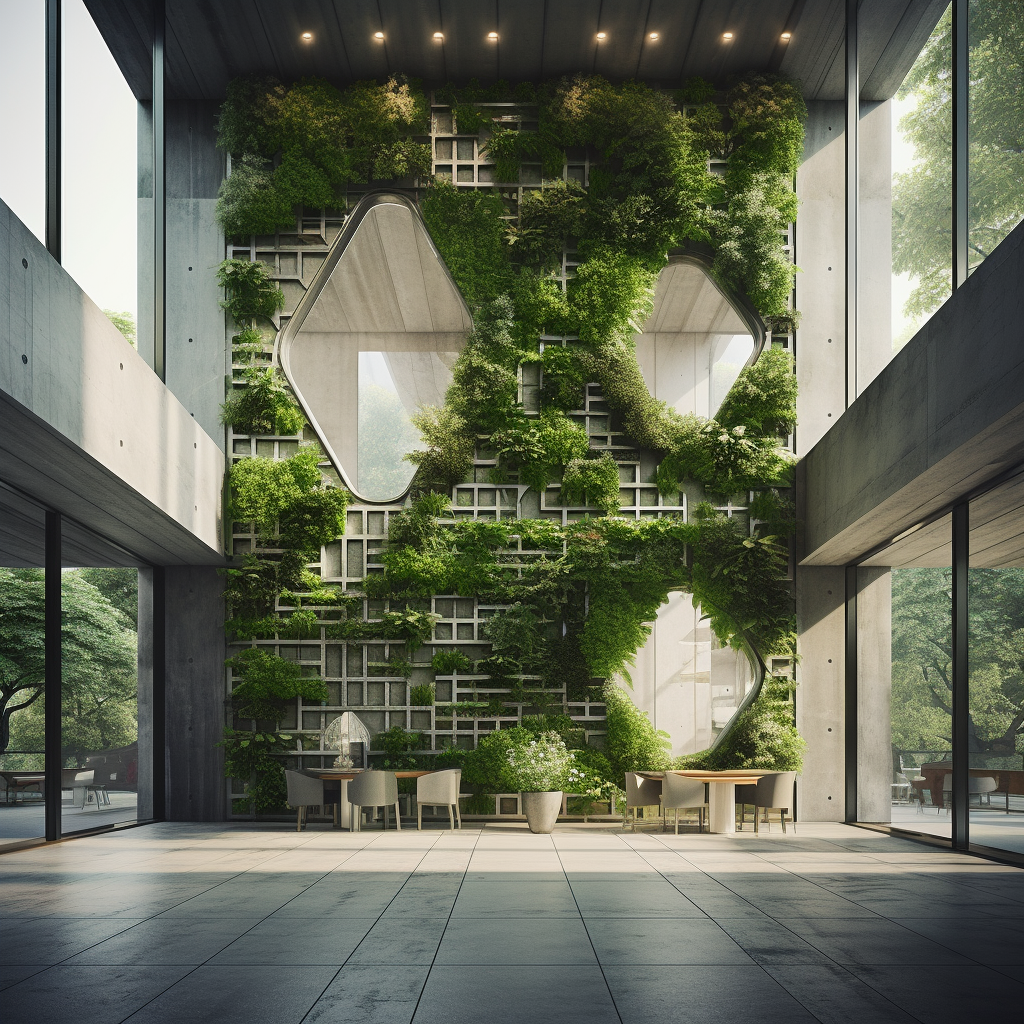Explore the latest trends in concrete finishes that are transforming commercial spaces with functionality and modern aesthetics.
The Art of Polished Concrete
Delve into the world of polished concrete, a sleek and sustainable flooring choice that’s gaining popularity in commercial design. Learn about its benefits, such as durability, low maintenance, and the ability to reflect light, enhancing the brightness of spaces.
-
Durability and Maintenance:
Polished concrete stands out as a remarkably durable option for commercial spaces, particularly in high-traffic areas. Its hard-wearing nature ensures it can withstand constant footfall and heavy equipment without showing significant wear and tear. This resilience makes it a go-to choice for retail spaces, warehouses, and corporate buildings where longevity is key. Polished concrete’s surface is resistant to stains and spills, which are often inevitable in busy environments.
In terms of maintenance, polished concrete is notably low-effort. It does not require frequent waxing or polishing – a simple routine of sweeping and damp mopping is usually enough to keep it looking pristine. The absence of grout lines eliminates the accumulation of dirt and grime, making the cleaning process even simpler. This ease of maintenance, combined with its durability, positions polished concrete as a cost-effective flooring solution over time.
-
Aesthetic Appeal:
Polished concrete is not just known for its practicality but also its aesthetic versatility. It offers a spectrum of finishes, from a subtle matte to a mirror-like high gloss, catering to diverse design preferences. This range allows architects and designers to tailor the flooring to complement the overall design theme of a commercial space. The reflective quality of high-gloss polished concrete can add brightness to a room, enhancing both natural and artificial light.
Moreover, the aesthetic of polished concrete can be further customized through the use of stains and dyes. These can infuse rich colors or create intricate patterns on the floor, adding an artistic touch to the functional surface. The sleek, modern look of polished concrete, combined with these customizable options, makes it a popular choice in contemporary commercial design, aligning aesthetics with utility.
-
Eco-Friendly Option:
Polished concrete is not only a practical and aesthetic choice but also an eco-friendly one. Its sustainability begins with the use of existing concrete slabs in many projects, reducing the need for new materials and minimizing waste. The longevity of polished concrete floors means less frequent replacements, further curtailing resource use and environmental impact over the long term.
Energy efficiency is another key environmental benefit of polished concrete. Its ability to reflect light can reduce the need for artificial lighting, thus lowering energy consumption. Additionally, its thermal mass helps to stabilize indoor temperatures, which can contribute to more efficient heating and cooling. These properties make polished concrete an ideal choice for projects aiming for environmental certifications or those simply seeking to reduce their ecological footprint.

Stamped and Decorative Concrete
Explore the versatility of stamped and decorative concrete, offering endless possibilities in texture, color, and pattern to create unique and inviting commercial spaces.
-
Customizable Designs:
Stamped concrete offers an extraordinary range of design possibilities, making it a highly versatile choice for commercial and residential spaces alike. It can replicate the look of natural stone, brick, tile, and even wood, providing a cost-effective alternative to more expensive materials. This versatility allows designers to achieve luxurious aesthetics without exceeding budget constraints. The variety of molds and stamping patterns available means that each project can have a unique, tailored appearance, from elegant slate replicas to intricate cobblestone effects.
Furthermore, stamped concrete is not limited to outdoor applications; it can also be used indoors to create distinctive flooring that complements the interior decor. The ability to integrate custom logos and bespoke designs into the concrete makes it particularly appealing for businesses looking to create a branded environment. Whether it’s for a sophisticated hotel lobby or a vibrant retail space, stamped concrete offers the flexibility to bring any design vision to life.
-
Color and Texture:
The color and texture possibilities with stamped concrete are virtually limitless. Advanced coloring techniques such as acid staining, integral color, dry-shake color hardeners, and tinted sealers allow for a wide spectrum of hues, from subtle earth tones to vibrant colors. These methods can create a depth and richness of color that mimics natural materials or offers something entirely unique. The surface texture of stamped concrete can be crafted to resemble the fine grain of wood, the roughness of stone, or the smoothness of tile, enhancing its visual appeal and tactile experience.
Each technique brings its own aesthetic and functional benefits. For instance, acid staining results in a variegated, translucent color effect, while color hardeners provide a more uniform color and increase the surface strength. The choice of colors and textures, combined with the stamping patterns, means that each stamped concrete installation can be a custom work of art, reflecting the specific style and needs of the space it inhabits.
-
Application Areas:
Decorative concrete is incredibly adaptable, suitable for a vast range of application areas. Its durability and aesthetic flexibility make it ideal for both indoor and outdoor spaces. Outdoors, it is commonly used for walkways, patios, pool decks, and driveways, providing a durable surface that can withstand weather elements while offering aesthetic appeal. The ability to blend seamlessly with the surrounding landscape makes it a popular choice for garden paths and courtyard flooring.
Indoors, decorative concrete finds its place in lobbies, showrooms, and even residential living spaces. Its ability to mimic other materials allows it to fit into various design schemes, from rustic to modern. Additionally, decorative concrete is valued in commercial spaces for its low maintenance requirements and long lifespan, making it a practical and attractive solution for high-traffic areas. Its use in a variety of settings showcases its versatility as a flooring material that can enhance the functionality and style of any space.

Sustainable and Innovative Concrete Solutions
Highlight the advancements in sustainable concrete solutions that are setting new standards in commercial construction, including eco-friendly mixes and self-healing concrete.
-
Eco-Friendly Concrete Mixes:
The development of eco-friendly concrete mixes is a significant advancement in sustainable construction, especially for commercial projects. These mixes incorporate environmentally friendly materials such as fly ash, slag, and recycled aggregates, reducing the reliance on traditional cement. This approach not only minimizes the carbon footprint associated with concrete production but also addresses waste management by repurposing industrial byproducts. The use of such sustainable mixes is increasingly favored in green building projects and is essential in achieving LEED certification for eco-conscious construction.
Eco-friendly concrete does not compromise on quality or structural integrity. In many cases, these green alternatives enhance the durability and strength of the concrete, making them ideal for commercial use. The shift towards eco-friendly concrete is not just a trend but a necessary step towards reducing the environmental impact of construction, aligning with global sustainability goals and the growing demand for responsible building practices.
-
Self-Healing Concrete:
Self-healing concrete represents a breakthrough in construction technology, offering a solution to one of the most common issues in concrete structures: cracking. This innovative material contains special agents, such as bacteria or microcapsules, that activate upon the formation of cracks, producing a healing agent to seal the cracks automatically. This technology drastically reduces the need for manual repairs and maintenance, significantly extending the life of commercial structures. It’s particularly beneficial for hard-to-reach areas or structures exposed to harsh environments.
The development of self-healing concrete is a response to the need for more sustainable and resilient building materials. By prolonging the lifespan of concrete structures and reducing maintenance requirements, it contributes to cost savings and resource efficiency. This technology is not only a testament to the innovation in the construction industry but also a step towards more sustainable and self-sufficient building designs.
-
Innovative Applications:
Innovative concrete solutions, including eco-friendly and self-healing concrete, are being embraced in modern commercial architecture to meet both aesthetic and functional requirements. These materials are being used in a variety of ways, from high-performance flooring solutions in retail spaces to durable and sustainable facades in office buildings. The versatility of these concrete solutions allows architects and designers to push the boundaries of traditional construction to create buildings that are both efficient and visually striking.
Moreover, the integration of these advanced concrete technologies plays a vital role in constructing buildings that are not only environmentally friendly but also cost-effective in the long run. They contribute to the creation of spaces that are not only pleasing to the eye but also functionally superior and aligned with the principles of sustainable development. As the construction industry evolves, these innovative applications of concrete are setting new standards for commercial architecture around the world.


Comments